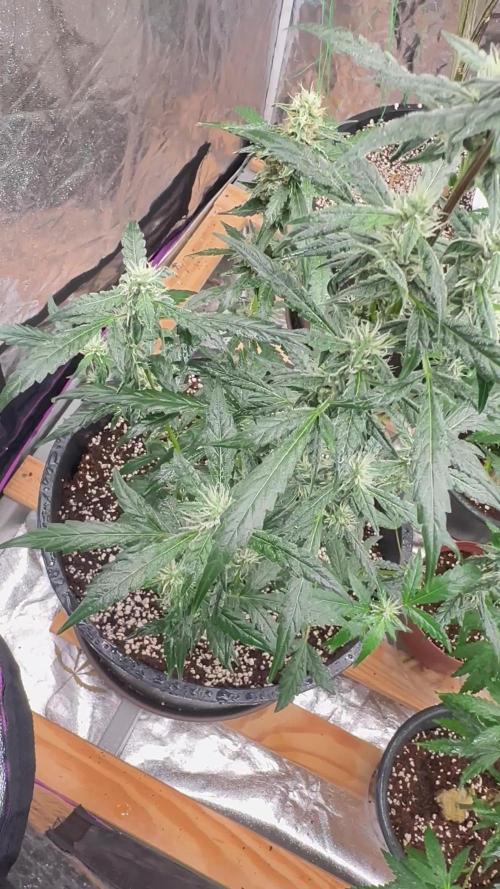The Grow Awards 2026 🏆 























Likes
Comments
Share


@Theia
Follow
Another one of the plants i opted to chop a bit earlier to give me some space to finish up my og kush and island punch.. The buds are great. Super sticky and very dense.. Layers of crystal and a lovely citronella and pine smell with some sweet undertones. Will be a nice smoke and i shall be back to report.
Thanks AMS
Likes
16
Share


@Oimjr
Follow
Wish I'd know about this site when she started. In week 9 since dropping the seed. Started Jan. 1st.
Likes
2
Share


@Cannabot
Follow
Love the blueberry strains,they have that smell that is unique to them.Really looking forward to blazing on this bad girl.Buds are getting nice and fat off all the bloom and light. Last bloom feed and then flush
Likes
2
Share


@High_Grade_Dadli
Follow
So far so good transplant to a 15 gal...good thing I didn't wait till nxt week...top soil sink to the bottom and was hand for the roots to get tru
Likes
12
Share


@Kirsten
Follow
Pink Mist is looking good, has stopped growing as much, and is starting to get into proper flower.
I have much else to say, however it seems I'm unable to, due to grow diaries cutting off all my comments, so I decided to save myself much time, and sadly just not say it!
Thanks for checking out my diary 🍃 ✌️
Likes
44
Share


@Papablob
Follow
20/06 Bien.. c'est raté. Vraiment.. complétement.. 😒. elle vas p'téte me faire 10g avec de la chance. Bon mais elle est en vie. Et tant qu'il y en a..
Likes
60
Share


@Secretflower
Follow
Hello my friends,
...May 17, 2022....Day N°65..
...Flowering day N°10...
My two Feminized Royal THCV are fine and beautiful, they are monster plants, they stretched about 30cm.
#1...100cm
#2.. 100cm
I give them water with a tablet of Easy Bloom tablet from RQS Organics Nutrients.
The HST working very well.
They are under a MarsHydro TSW 2000 at 50% of power and at 40cm of the canopy.
www.royalqueenseeds.com
www.mars-hydro.com
Thank you very much for passing by.
Wish you the best with your green projects, peace.
See you soon 💨💨💨
Likes
30
Share


@BillMonroe
Follow
Harvest update in 2 weeks or so :)
I wanted to let them go a bit longer but the mildew was going to take over so I chopped the plants and rinsed them in water + H2O2.
Lots of lessons learned ... Lots of bud hanging on the vine. Good luck to everyone
Likes
9
Share


@julian100614
Follow
NORTHERN LIGHT AUTO (ROYAL QUEEN SEEDS)
Descripción:
Poco después de conquistar la escena del cannabis en Holanda, la Northern Lights se convirtió en el estándar del cultivo en interior. Su influencia se extendió por todo el mundo y acabaría convirtiéndose en uno de los pilares del desarrollo de cepas de cannabis modernas. Durante los últimos años, las técnicas de cultivo y reproducción han generado versiones de Northern Lights que mantienen las características de esta leyenda mientras añaden algo interesante a la fórmula. La Northern Light Automatic de Royal Queen Seeds es la combinación perfecta entre lo nuevo y lo viejo.
Al tratarse de una cepa autofloreciente y feminizada, la Northern Light Automatic es una planta versátil, perfecta para cultivadores discretos de interior pero también para cultivadores de exterior a gran escala. Tras una breve fase vegetativa, la planta empieza a crecer y a producir gran cantidad de flores, terminando su ciclo de vida en solo 9 o 10 semanas desde que se planta la semilla.
Día 0: He germinado la semilla en un papel humedecido a 30°C con un pH6
Día 1: La semilla abrió perfectamente y la trasplanté rapidamente a su maceta final de 15L geotextil de Royal Queen Seeds y he puesto en el agua de riego Deeper Underground 1ml/l y Atami NRG Roots-C 2ml/l.
Día 2: La pequeña ha cogido 3cm y va creciendo rapidamente. Parece que los nutrientes hacen sus efectos perfectamente
Día 3: después de alcanzar los 3cm hoy hemos regado con el enrraizador para su sistema radicular aportando 1ml/l Deeper Underground y 2ml/l de Atami NRG Roots-C
Processing
Likes
12
Share


@Pauwela
Follow
7/7 These girls are 28 days old, roots appearing at bottom of 3 gal bag, time to transplant to 7 gal bags
Likes
7
Share


@WeedleyScott
Follow
Woche 8 geht los, die Lampen stehen auf 100% Grow und 100% Flower, ich habe ein Netz rein gespannt und nach 1–2 Tagen in der letzten Woche alles weggeschnitten, was unterm Netz war sowie einige Seitentriebe. Somit sollte jeder Hauptstrang maximal 4–5 Seitentriebe haben.
Zudem fangen sich die Blüten an zu bilden und es sind deutliche Härchen zu sehen.
Update: Tag 5 Woche 9: Die Blüten werden immer größer und harzen schon auf die umliegenden Blätter 😍
Likes
21
Share


@DogterB
Follow
Week 11
Day 71 (9/25)
Well I made an partially informed decision with her. I went ahead and gave her a mini flush, ran 3 gallons of water through her to try and get some of the excess nutrients out. I'll give a few days, then will feed her again. I'm going to try and remember to bust out the microscope tonight and check her trichomes. She's still got plenty of white pistils, but I just need to see if I am actually able to see the trichs for when the time comes.
Day 72 (9/26)
Her pot was still fairly heavy this morning, so no plans to feed today. I'm thinking tomorrow she'll be ready. I feel so bad for her, she's looking kinda pitiful. I did get a chance to try out a cheap little phone clip on microscope I have. It was difficult to get it down to the bud, but took a few pics. These are zoomed in on the small area that it actually captured. Worked out okay, but it's gotta be like ON the bud to see anything, and now it's sticky and funky. Which to be fair, isn't really a bad thing. I think it will work well enough to check trichomes for readiness. Her pistils are browning surprisingly quickly, I wasn't expecting that. I may start checking trichomes every few days or so.
Day 73 (9/27)
Wasn't able to get on and get posted yesterday, the mother-in-law was at our house all day. But she was feeding us mushrooms all day, so I guess that's okay lol.
Day 74 (9/28)
I was able to get up early and get her fed. Her smell is amazing, sweet and potent. I messed around a bit with the microscope but it's pretty hard to get decent pics.
Day 75 (9/29)
Played around with the microscope a bit last night. It's pretty hard to get clear shots of the trichomes, but I'm getting better at it the more a mess with it. Debating on getting a handheld microscope off amazon or something, just to try to make it easier and more clear to see the trichomes. Currently working on the wife about getting some lights for the 4x4 and getting that tent going. I'd like to be able to run multiple plants!
Day 76 (9/30)
She's getting closer and closer! After the flush, it seems like the lockout is over as she isn't progressing like she was.
Day 77 (10/1)
I pulled out the microscope lens for my phone and checked trichomes. Realized I was probably better off just taking a video and checking multiple buds. Worked out pretty good, just paused the video when I had a clear shot and was able to zoom in and such to look closer. Here I am...just waiting....waiting...waiting...waiting...






























